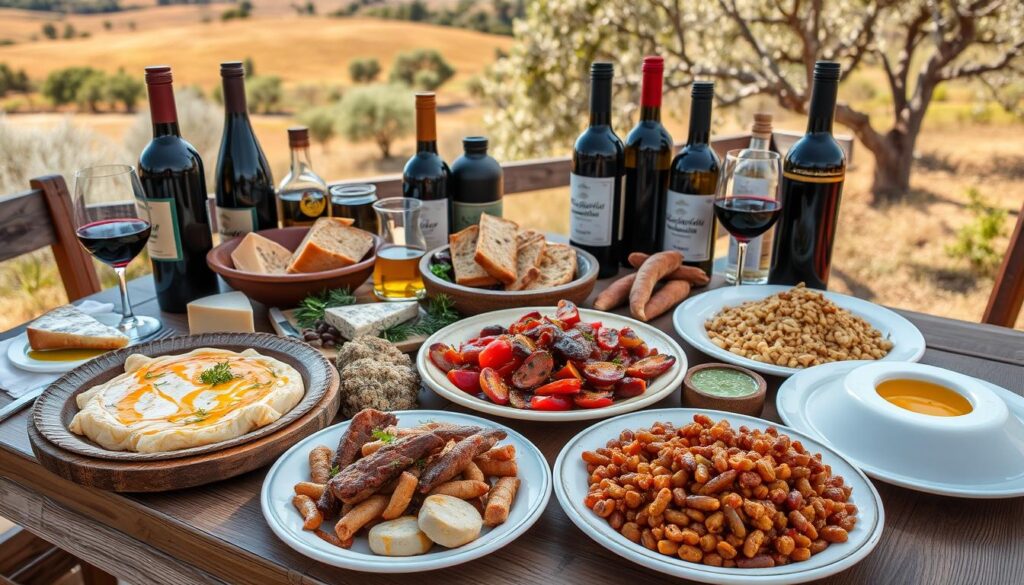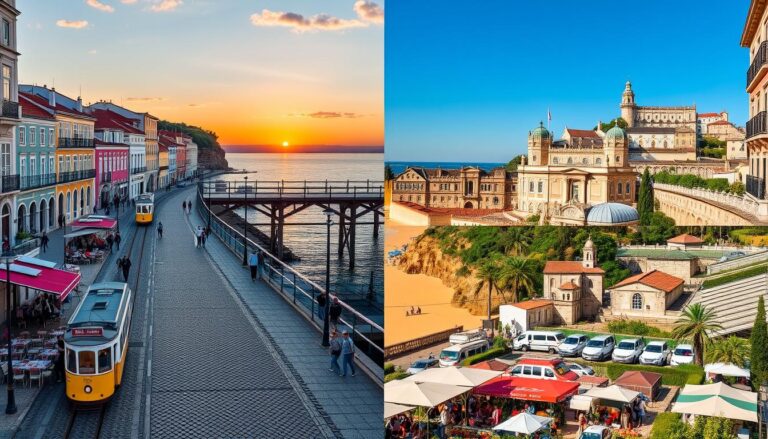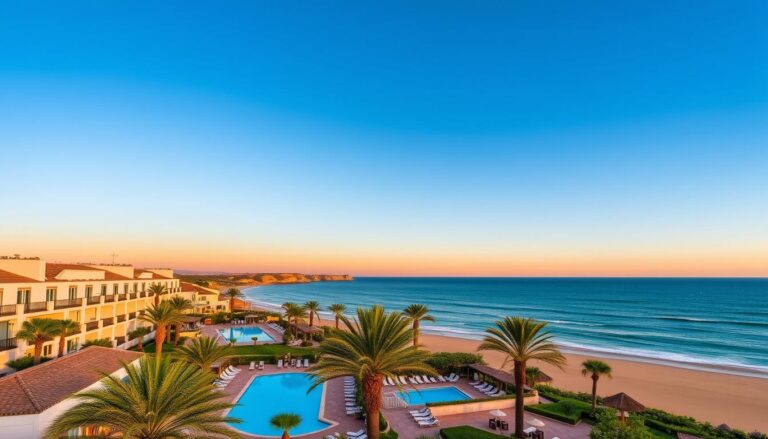Discover the Charms of Alentejo, Portugal
The warm Portuguese sun lights up Alentejo’s rolling landscapes. It feels like time has stopped. This area covers almost 30% of Portugal and invites you to explore its untouched beauty and rich culture. Your trip here will be a real adventure, away from the usual tourist spots.
Traveling in Alentejo portugal is more than visiting a place. It’s diving into a centuries-old way of life. You’ll see medieval villages in cork forests and vast plains with ancient olive trees. This region shares stories of strength, tradition, and natural beauty.
If you love history, food, or just want a real travel experience, Alentejo is perfect. You’ll see everything from calm coastlines to historic towns. Each place offers a unique view into Portuguese culture, making your imagination soar and touching your heart.
Get ready to experience a place where being real is more than a word—it’s a lifestyle. Your journey in Alentejo is waiting, filled with memories that will stay with you forever.
Table of Contents
A Brief Overview of Alentejo’s Rich History
Alentejo’s history is a tale of time standing still. This region, almost 30% of Portugal, has seen many cultural changes. With only 7% of Portugal’s people, it offers a rare look into history.
The history of Alentejo goes back to the Romans. Its key location has made it crucial in Portugal’s defense. Today, it’s a treasure trove for those interested in history and culture.
Historical Significance of Alentejo
Alentejo’s history is layered with cultural heritage:
- Roman settlements dating back to 2 AD
- Medieval defensive border towns
- UNESCO World Heritage sites like Évora
- Preserved architectural landmarks from different epochs
Key Historical Sites to Visit
Don’t miss these sites on your Alentejo tour:
| Site | Historical Significance | Location |
|---|---|---|
| Roman Temple of Évora | 2 AD Roman architectural marvel | Évora City Center |
| Aqueduct of Amoreira | 16th-century UNESCO World Heritage site | Elvas |
| Almendres Cromlech | Prehistoric megalithic complex | Near Évora |
Alentejo is a journey through Portugal’s rich past. Every stone and building has a story. It’s a place where history comes alive for those who seek it.
The Breathtaking Landscape of Alentejo
Explore the stunning beauty of Alentejo, a region that amazes everyone with its varied and beautiful scenery. It covers one-third of Portugal and offers a unique journey. You’ll see rolling plains, lush vineyards, and dramatic coastlines.
Rolling Plains and Vineyards
As you explore Alentejo, you’ll see endless views. The region’s landscape includes:
- Vast cork oak forests
- Extensive olive groves
- Meticulously maintained vineyards
- Picturesque agricultural fields
Coastal Beauty and Natural Parks
The Alentejo coastline, known as Costa Vicentina, is a stunning contrast to the plains. It has beautiful beaches and rugged cliffs. These offer amazing natural beauty and outdoor adventures.
| Natural Highlight | Key Features |
|---|---|
| Praia Grande | One of the region’s most renowned beaches |
| Odeceixe Beach | Unique location at the mouth of Seixe River |
| Serra de São Mamede Natural Park | Rich biodiversity and hiking opportunities |
Whether you love nature, wine, or just beautiful views, Alentejo is unforgettable. It’s a journey through Portugal’s most diverse and stunning landscapes.
Exploring Alentejo’s Unique Cuisine
Discover the rich culinary landscape of Alentejo. Here, food tells stories of tradition, agriculture, and cultural heritage. Alentejo cuisine is a journey through Portugal’s most authentic flavors. It blends rustic ingredients with old cooking techniques.

Traditional Dishes You Must Try
Your culinary adventure in Alentejo starts with these iconic dishes. They show the region’s rich agricultural abundance:
- Açorda à Alentejana: A traditional bread-based soup with poached eggs. It shows the region’s resourceful cooking style
- Ensopado de Borrego: A tender lamb stew slow-cooked to perfection
- Migas Alentejanas: Sautéed breadcrumbs with savory pork or sausages
- Porco Preto: Unique black Iberian pig dishes with distinctive acorn-fed flavors
Local Wine Varieties: A Tasting Journey
Alentejo wine region offers an exceptional wine experience. It complements its extraordinary cuisine. The area is famous for its distinctive wine production, especially Vinho da Talha. This wine is fermented in traditional clay amphorae, offering earthy and complex flavors.
- Explore local wineries specializing in red and white wine varieties
- Sample unique wines crafted using centuries-old techniques
- Experience wine tastings that reveal the region’s viticultural heritage
Immerse yourself in Alentejo’s culinary world. Every bite and sip tells a story of passion, tradition, and exceptional craftsmanship.
Cultural and Artistic Treasures of Alentejo
Alentejo culture is a vibrant mix of traditions, art, and creativity. It invites travelers to explore its rich heritage. Here, you can discover Portugal’s artistic soul through its cherished cultural expressions.
The heart of Alentejo tourism is its festivals and crafts. Visitors can dive into a world of authentic experiences. These show the region’s deep cultural identity.
Festivals That Celebrate Life
Alentejo comes alive with vibrant cultural events all year. Some festivals you must see include:
- Évora Wine Festival – celebrating local wine traditions
- Traditional Music Encounters in historic town squares
- Arraiolos Carpet Festival – highlighting local textile arts
- Regional Food and Harvest Celebrations
Artisan Crafts of Alentejo
The region’s artistic heritage is seen in its traditional crafts. Arraiolos is famous for its hand-embroidered rugs, perfected over generations.
Key artisan crafts include:
- Hand-woven Arraiolos Carpets
- Estremoz Clay Figurines
- São Pedro do Corval Pottery
- Traditional Cork Crafts
Exploring Alentejo culture, you’ll find workshops where artisans keep old traditions alive. Local markets and museums let you see artisans at work. You can also buy authentic souvenirs that tell the story of this remarkable region.
Alentejo tourism offers a unique chance to connect with living cultural traditions. From intricate crafts to lively festivals, you’ll find a world of artistic expression. This captures the spirit of this extraordinary Portuguese landscape.
Outdoor Activities and Adventures in Alentejo
Alentejo is a paradise for adventure lovers. It has everything from rugged trails to beautiful beaches. This region is full of activities that will excite your sense of adventure.
The Alentejo region is vast and offers many active experiences. Its varied landscapes mean there’s something for everyone, no matter your skill level or interest.
Hiking Trails for Every Adventurer
Alentejo has hiking trails for all, from easy walks to tough treks. Some top trails include:
- Serra de São Mamede Natural Park: Intermediate trails with stunning panoramic views
- Costa Vicentina: Coastal paths with breathtaking ocean landscapes
- Rota Vicentina: Well-marked historical trails showcasing regional beauty
There are trails for every hiker, from easy to challenging. This means everyone can find their perfect trail in Alentejo.
Water Sports Along Alentejo Beaches
Alentejo’s beaches are perfect for water sports fans. The Costa Vicentina is especially great for:
- Surfing: Ideal waves for beginners and advanced surfers
- Kayaking: Exploring hidden coastal caves and pristine shorelines
- Stand-up paddleboarding: Calm waters perfect for all skill levels
Tróia Peninsula is famous for its 18 kilometers of white sand beaches. It’s a great place for water sports.
Additional Outdoor Experiences
Alentejo has more than just hiking and water sports. You can also enjoy:
- Birdwatching in Sado Estuary
- Stargazing in dark sky reserves
- Mountain biking through scenic landscapes
Alentejo travel offers many outdoor adventures. Whether you want excitement or a peaceful experience, Alentejo has it all.
The Warmth of Alentejo’s Villages
Explore the heart of Alentejo, Portugal, through its charming rural villages. These places keep alive centuries of culture. They give visitors a real look at traditional Portuguese life, where time is slower.
Alentejo’s villages are full of life, each with its own story of strength and community. The area has over 100 local markets. These markets show off the lively traditions and connect visitors with rural life.
Notable Villages to Explore
- Monsaraz: A hilltop village with medieval castle walls and breathtaking panoramic views
- Marvão: Perched on a rocky outcrop, offering stunning landscapes and historical significance
- Castelo de Vide: Known for its Jewish heritage and beautiful whitewashed houses
Engaging with Local Communities
Traveling through Alentejo’s villages can be very rewarding when you meet the locals. Here are some real experiences:
- Attend traditional local markets
- Participate in harvest festivals
- Stay in rural guesthouses
- Learn traditional crafts from local artisans
| Village | Unique Feature | Cultural Highlight |
|---|---|---|
| Monsaraz | Medieval Castle | Traditional Handicrafts |
| Marvão | Mountain Views | Local Wine Production |
| Évora | UNESCO World Heritage Site | Historic Architecture |
With over 300 registered artisans, Alentejo offers a deep cultural dive. Your visit supports local communities and keeps their traditions alive.
Finding the Perfect Accommodations
Finding the right place to stay in Alentejo can make your trip unforgettable. The area has many lodging choices for all budgets and tastes. This ensures your trip to Alentejo is both cozy and memorable.
Luxury Hotels and Unique Stays
Alentejo is known for its top-notch luxury stays that mix comfort with local flair. Some top picks include:
- Villa Extramuros: A boutique hotel with just five luxury rooms, offering an intimate experience
- Casa Nossa: Features 10 elegant suites
- Vermelho Hotel: A sophisticated 13-room property in Melides
- São Lourenço do Barrocal: A converted winery and olive grove providing unique stays
Budget-Friendly Options in Alentejo
For those looking for affordable stays, Alentejo has many charming options:
- Quinta da Amendoeira: Offers apartments named after local wineries
- Reflexos d’Alma: Provides 6 intimate suites
- Rural guesthouses in traditional villages
- Hostels with authentic local experiences
Your perfect Alentejo trip is waiting, with everything from luxury resorts to budget-friendly spots. These places capture the region’s special spirit.
Wine Tours: A Deep Dive into Alentejo’s Vineyards
Explore the magical Alentejo wine region in southern Portugal. It’s a hidden treasure for wine lovers and curious travelers. The area’s unique soil and long winemaking history make it a special journey.
Recommended Wineries to Explore
Alentejo’s wineries are the stars of wine tourism. Here are the top vineyards you must see:
- Borba Sub-Region: Known for red grape varieties like Alicante Bouschet and Trincadeira
- Redondo Vineyards: Features granitic soils perfect for Antão Vaz and Aragonez grapes
- Estremoz Estates: Produces wines with strong personalities using Aragonez and Castelão grapes
Planning Your Perfect Wine Tour
For the best Alentejo wine experience, follow these tips:
- Book guided tours with local operators like Alentejo Viti Tours
- Visit during festival seasons like Migas Week or Capuchos Festival
- Explore different wine varieties and their unique characteristics
Wine Tour Options and Pricing
| Tour Name | Duration | Price | Rating |
|---|---|---|---|
| Alentejo Wine Tour from Évora | 3-4 hours | 70€ | 5/5 Stars |
| Monsaraz Wine Tasting Tour | 3-4 hours | 65€ | 5/5 Stars |
| 4×4 Cork Tour with Wine Tasting | 3-4 hours | 160€ | 5/5 Stars |
Your wine tour in Alentejo will be unforgettable. You’ll enjoy intimate tastings, beautiful views, and rich culture.
Practical Tips for Visiting Alentejo
Planning your trip to Alentejo needs careful thought about when to go and how to get there. This guide will help you understand the region and enjoy your visit.
Best Times to Visit Alentejo
Choosing the right time to visit Alentejo can make your trip better. The region has different charms for each season:
- Spring (April-May): Mild weather and beautiful wildflowers
- Fall (September-October): Nice weather and grape harvest festivals
- Avoid summer months (June-August) because it’s very hot

Transportation Options in the Region
Getting around Alentejo needs some planning. While public transport is available, renting a car is best for exploring.
| Transportation Method | Pros | Cons |
|---|---|---|
| Car Rental | Maximum flexibility, access to rural areas | Higher cost, parking challenges in small towns |
| Regional Buses | Budget-friendly, connects major towns | Limited schedules, slower travel |
| Train | Comfortable, scenic routes | Limited coverage in rural regions |
Insider tip for alentejo travel: Book your rental car early. Also, know the local driving rules for a smooth trip.
Creating Your Itinerary: Must-See Highlights
Planning your trip to Alentejo, Portugal, is key to a great adventure. This region is vast, covering nearly one-third of Portugal, yet it’s home to less than 8% of its people. It’s a perfect place to dive into rural Portuguese culture and see its beautiful landscapes.
Start your journey in Évora, a UNESCO World Heritage site, just 137 km from Lisbon. Spend a day here to walk its historic streets, see the Roman Temple of Diana, and try local food. Don’t miss the Almendres Cromlech, a prehistoric stone circle, just 28 minutes away.
Suggested 3-Day Itinerary
For a deep dive into Alentejo, plan your days around culture, food, and nature. Begin with a wine tour at Cartuxa Winery near Évora. Try the famous Pera Manca red wine. Then, head to the coast for stunning views and outdoor fun. October is great for harvest festivals and exploring.
Balancing Relaxation and Adventure
Your Alentejo trip should mix exploring with relaxing. Make time for hiking, visiting villages, and enjoying long meals. The region’s beauty is in its slow pace. So, leave room for surprises and getting to know the locals.







